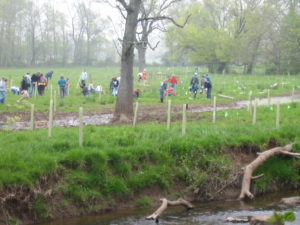
A new study found just one acre of riparian forested buffer results in more than $10,000 in annual economic benefits, including reducing erosion and flooding, increasing water purification, wildlife habitat, and property values. The study—The Economic Value of Riparian Buffers in the Delaware River Basin—was prepared by ECONorthwest for the Delaware RiverKeeper Network.
Specifically, the report looks at the value riparian buffers provide in the areas of water quality, carbon storage, air quality, flood prevention, property values, wildlife habitat, and outdoor recreation. The report shows the economic value provided by riparian buffers far exceeds the cost of protecting and restoring these buffers.
According to the report: “Translated to a single acre, buffers provide over $10,000 per acre per year in monetized benefits, with additional non-monetized benefits expected to increase this total.”
“Beyond their amazing environmental benefits, this analysis shows that each protected acre of riparian buffer yields more than $10,000 every year in ecosystem services for our economy,” said Maya van Rossum, the Delaware Riverkeeper and leader of the Delaware Riverkeeper Network. “Most reports and discussions regarding buffers preservations focuses on the health, safety and environmental benefits, this report shows the incredible economic value riparian buffers provide as well—both in making money and saving money for communities. Clearly, protecting and restoring these waterway corridors results in huge benefits to society.
“Combined with the ecological benefits from protected riparian zones, strengthening buffers is one of the most important efforts we can make in every community and watershed to simultaneously strengthen our economies while protecting and restoring our cherished aquatic ecosystems,” said van Rossum. “This report also solidifies how incredibly foolish efforts to minimize buffers protection at the local and state government level are– we should be increasing protections not reducing them.”
With 17 million people relying on the Delaware River watershed for drinking water, it is important to protect and implement riparian buffers.
The report notes: “Almost half of the Basin’s historic riparian cover has been lost to agriculture, shopping malls, housing developments, and highways.”
The report highlights how investing in watershed protections can save money. For example, New York City invests $1.5 billion into watershed protection, thereby eliminating the costs associated with a water filtration plant, which could cost as much as $8 billion initially with an additional $300 million per year to operate.
Protecting buffers benefits both the environment as well as the economy, and failure to do so could result in the loss of millions of dollars.
The report states: “Without more effective protection for riparian buffers, we estimate an annualized loss of approximately $981 thousand to $2.5 million in the value of monetized ecosystem services.”
Click here for a copy of the report. Click here for and overview of the multiple benefits of green infrastructure.






